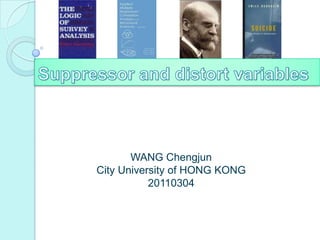
Suppressor and distort variables
- 1. Suppressorand distort variables WANG Chengjun City University of HONG KONG 20110304
- 5. Normal situation Because the variables share variance and influence . each semi-partial correlation, and the corresponding beta, will be less than the simple correlation between Xi and Y. Y X1
- 6. Classical suppression: rY2 = 0 The presence of X2 will increase the multiple correlation, even though it is not correlated with Y. X2 suppresses some of error variance in X1.
- 7. Suicide rate and religion Durkheim argues that if we control the variable of education, the suicide rate of Jews people will be even smaller. Jews are assumed to be a more integrated group.
- 8. Distort variables Y Y - Distort variable converts a positive relationship into a negative relationship. + X2 X1 X1 -
- 10. Distort variables Zero order correlation between marriage and suicide rates indicates that marriage make people tend to suicide. Marriage make people more integrated, so the married people should have less suicide rate.
- 11. Keep model complete For regression: y=b1*x1+b2*x2, if |ry1|<|b1| For regression: y=b1*x1+b2*x2, if ry1*b1<0 Suppressor and distort variables remind us to keep the model complete.
- 12. Appendix 1 A simulation of suppression ################Jonathan'sexample############################ # see http://zjz06.spaces.live.com/blog/cns!3F49BBFB6C5A1D86!341.entry y<-c(1,2,3,4,5) x1<-c(2,3,4,5,1) x2<-c(3,2,1,4,5) cor(y,x1);cor(y,x2);cor(x1,x2) ################## partialcorrelations###################### library(ggm) data<-cbind(y,x1,x2) # partial correlation between y and x1controlling for x2 pcor(c('y','x1','x2'),var(data)) pcor(c('y','x2','x1'),var(data)) # regression partials the effect ofsupression fit12<-lm(y~x1+x2) summary(fit1);summary(fit2);summary(fit12) library(QuantPsyc) lm.beta(fit12) #########visualize the data in correlationmatrices########### library(corrgram)#install.packages('corrgram') corrgram(data, order=TRUE,lower.panel=panel.shade, upper.panel=panel.pie,text.panel=panel.txt, main="Suppression in zero ordercorrelation")
- 13. Appendix 11 A simulation of distortion set.seed(20110303) y<-rnorm(10000) x2<--0.1*y+0.01*rnorm(10000) x1<-0.8*x2+0.01*rnorm(10000) cor(x1,x2);cor(x1,y);cor(x2,y); plot(data.frame(cbind(y,x1,x2)), col='3') f1<-lm(y~x1) f2<-lm(y~x2) f3<-lm(y~x1+x2) f4<-lm(x1~x2) summary(f1);summary(f2);summary(f3);summary(f4)
